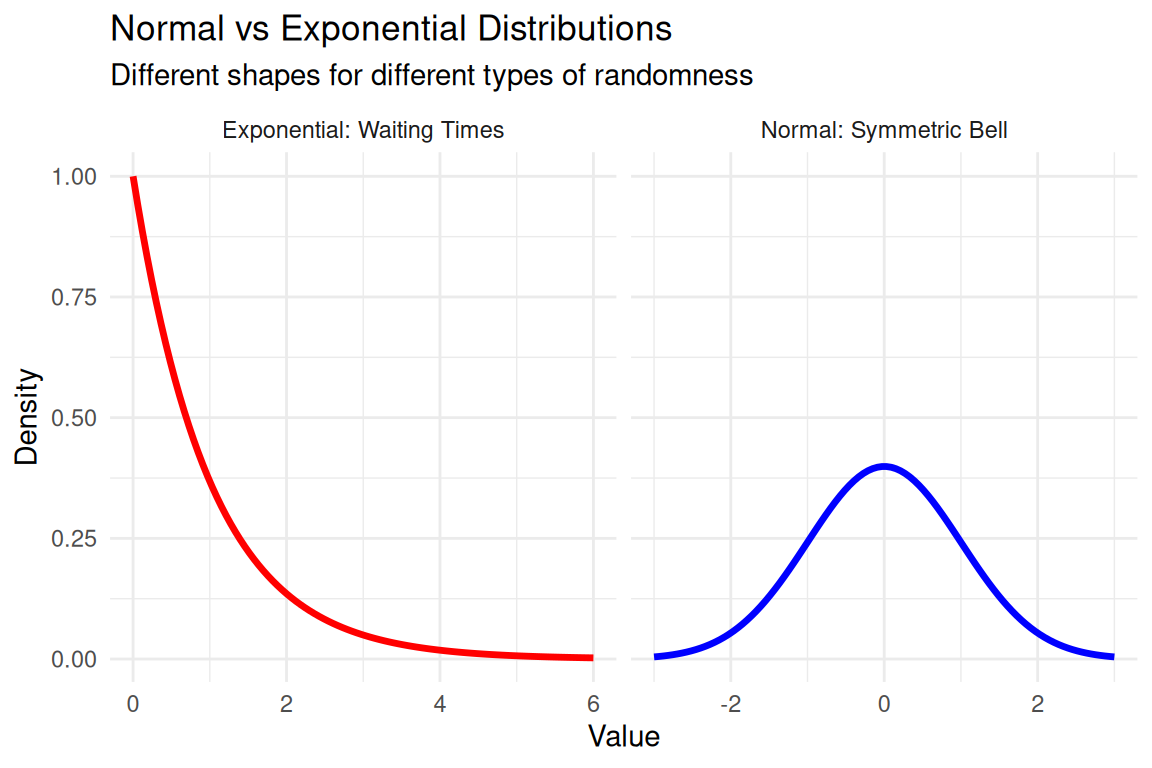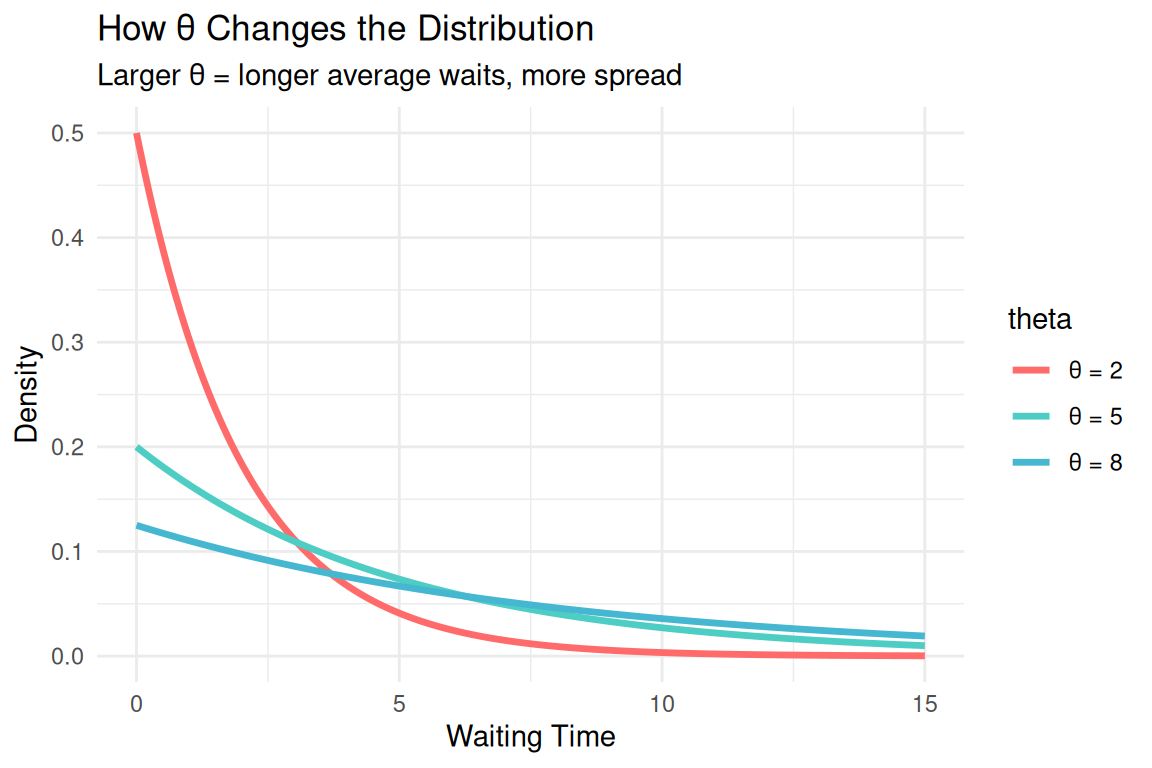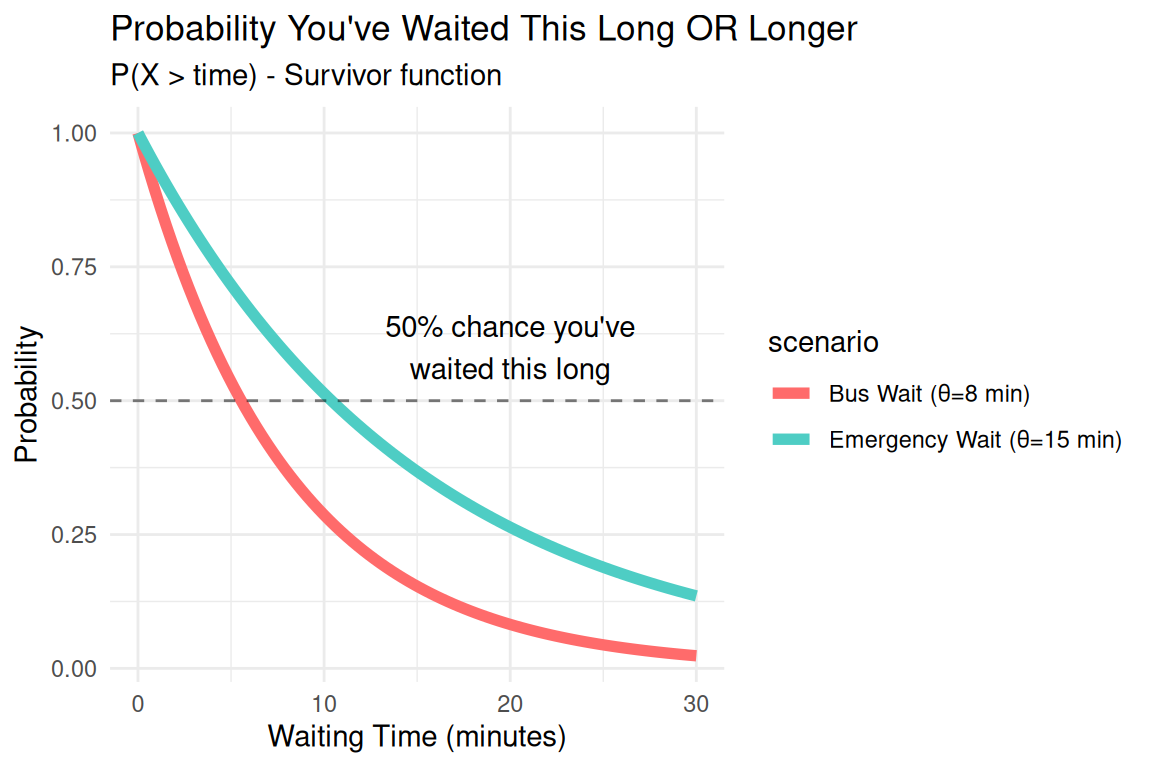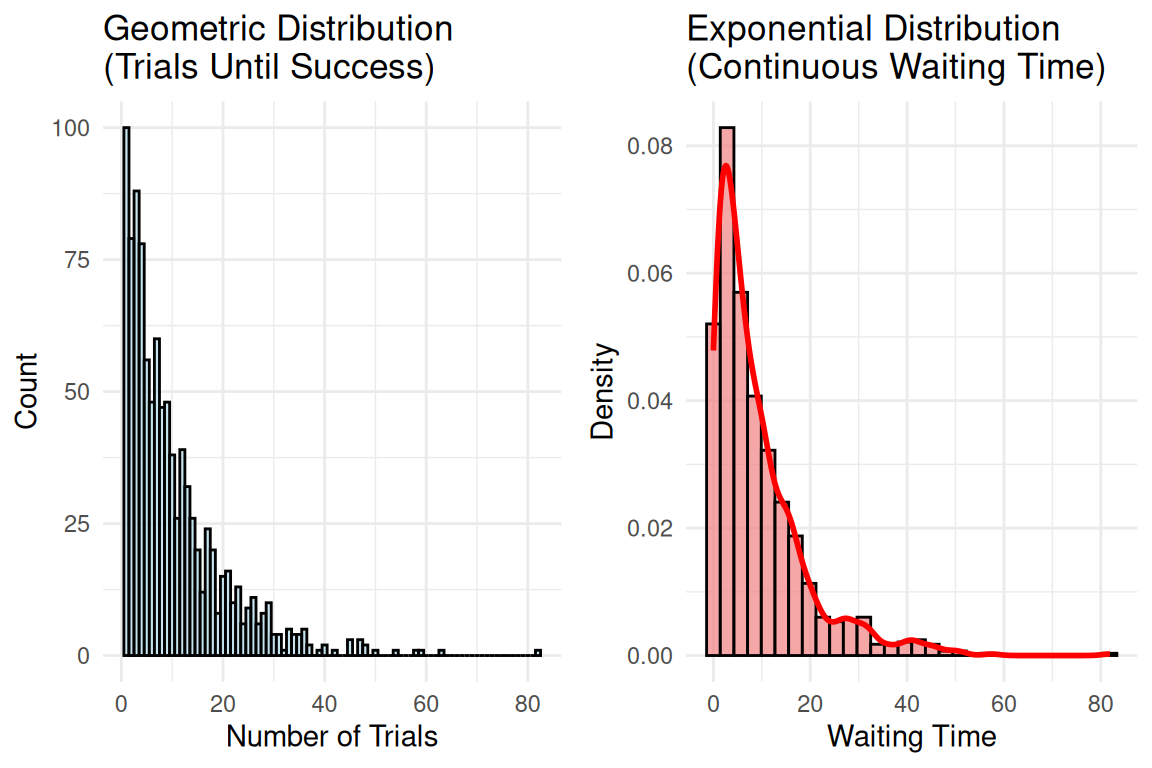
Day 15
Math 216: Statistical Thinking
The Exponential Distribution: When Time Matters
Think about it: You’re waiting for the bus, your phone battery is dying, and you need to know - how long until the next one arrives? The exponential distribution is your crystal ball for waiting times!
Real-World Detective Work:
- Urban Planning: When will the next bus arrive?
- Tech Support: How long until your laptop crashes again?
- Emergency Services: When will the next 911 call come in?
- Quality Control: How long until this machine breaks down?
From Normal to Exponential: A New Type of Randomness
The Big Idea: Models waiting times between completely random events
Properties:
- Memoryless: Past waiting doesn’t affect future waiting
- Single Parameter: θ controls everything (mean = std dev!)
- Scale Matters: Larger θ = longer average waits
Detective’s Secret: If events happen randomly over time, waiting times follow exponential!
The Exponential Formula
Definition
The exponential distribution describes the time between events in a Poisson process, where events occur continuously and independently at a constant average rate.
Probability Density Function (PDF): \[f(x)=\frac{1}{\theta} \exp \left(-\frac{x}{\theta}\right), \quad x>0\]
- \(\theta\): Scale parameter (mean waiting time)
- \(x\): Waiting time between events
- Key Insight: The probability decays exponentially with time!
Statistical Measures

Key Parameters:
- Mean: \(\mu=\theta\) (Average waiting time)
- Rate: \(\lambda=\frac{1}{\theta}\) (Events per unit time)
- Standard Deviation: \(\sigma=\theta\) (Spread equals mean!)
- Variance: \(\sigma^2=\theta^2\)
Real-World Interpretation:
- θ = 2 minutes: Buses arrive every 2 minutes on average
- θ = 5 hours: Equipment fails every 5 hours on average
- θ = 30 days: Customer complaints every 30 days on average
Calculating Probabilities

Probability Work:
The Golden Formula: \(P(X \text{ > } a) = \exp\left(-\frac{a}{\theta}\right)\)
Bus Example (θ = 8 min):
- P(X > 5 min) = exp(-5/8) = 53.5%
- P(X > 15 min) = exp(-15/8) = 15.3%
- P(X > 30 min) = exp(-30/8) = 2.4%
Emergency Room (θ = 15 min):
- P(X > 10 min) = exp(-10/15) = 51.3%
- P(X > 30 min) = exp(-30/15) = 13.5%
Insight: Long waits become exponentially unlikely!
Calculating Probabilities and Quantiles in R
pexp: Calculates the cumulative probability for a given value.
- Syntax:
pexp(q, rate = 1, lower.tail = TRUE) - Computes \(P(X \leq x)\) or \(P(X > x)\) for an exponential distribution.
- Examples:
pexp(5, rate = 1/2)calculates \(P(X \leq 5)\) for \(\theta = 2\).pexp(5, rate = 1/2, lower.tail = FALSE)for \(P(X > 5)\).
Calculating Probabilities and Quantiles in R
qexp: Computes the quantile for a specified probability.
- Syntax:
qexp(p, rate = 1, lower.tail = TRUE) - Finds the smallest \(x\) such that \(P(X \leq x) \geq p\).
- Examples:
qexp(0.7, rate = 1/2)finds the time by which 70% of events are expected to occur for \(\theta = 2\).
Geometric vs Exponential: The Connection

- Geometric: “How many resumes until I get a job offer?”
- Exponential: “How long until I get my next job offer?”
Geometric Distribution (Discrete Cousin)
- Counts: Number of trials until first success
- Examples: Coin flips, dice rolls, survey responses
- Memoryless: Past failures don’t affect future success
Exponential Distribution (Continuous Sibling)
- Measures: Continuous waiting time between events
- Examples: Time, distance, continuous measurements
- Memoryless: Past waiting doesn’t affect future waiting
Case 1: Coffee Shop Rush Hour
The Scenario: Starbucks manager wants to know staffing needs during morning rush
Data: Average time between customer orders = 2.5 minutes (θ = 2.5)
Questions:
# Coffee shop analysis
theta_coffee <- 2.5
# Q1: What's the probability a customer arrives within 1 minute?
p_within_1min <- pexp(1, rate = 1/theta_coffee)
sprintf("P(wait ≤ 1 min) = %.1f%%", p_within_1min * 100)[1] "P(wait ≤ 1 min) = 33.0%"# Q2: How long until 80% of customers have arrived?
time_80_percent <- qexp(0.8, rate = 1/theta_coffee)
sprintf("80%% arrive within %.1f minutes", time_80_percent)[1] "80% arrive within 4.0 minutes"# Q3: Probability of waiting more than 5 minutes for next customer?
p_over_5min <- pexp(5, rate = 1/theta_coffee, lower.tail = FALSE)
sprintf("P(wait > 5 min) = %.1f%%", p_over_5min * 100)[1] "P(wait > 5 min) = 13.5%"Manager’s Insight: Most customers arrive quickly, but occasional long gaps allow barista breaks!
Case 2: Tech Support Response Times
The Scenario: IT helpdesk promises 90% of tickets resolved within target time
Data: Historical average resolution time = 4.2 hours (θ = 4.2)
Investigation:
# Tech support analysis
theta_tech <- 4.2
# Q1: What time should we promise for 90% resolution?
promise_time <- qexp(0.9, rate = 1/theta_tech)
sprintf("Promise resolution within %.1f hours for 90%% success", promise_time)[1] "Promise resolution within 9.7 hours for 90% success"# Q2: What's the probability a ticket takes over 8 hours?
p_over_8hr <- pexp(8, rate = 1/theta_tech, lower.tail = FALSE)
sprintf("P(resolution > 8 hr) = %.1f%%", p_over_8hr * 100)[1] "P(resolution > 8 hr) = 14.9%"# Q3: Median resolution time?
median_time <- qexp(0.5, rate = 1/theta_tech)
sprintf("50%% of tickets resolved within %.1f hours", median_time)[1] "50% of tickets resolved within 2.9 hours"Service Level: Promise 9.7 hours for 90% success rate, but most tickets (50%) solved in 2.9 hours!
Case 3: Quality Control Testing
The Scenario: Manufacturing plant tests equipment reliability
Data: Average time between failures = 45 days (θ = 45)
Reliability Analysis:
# Quality control analysis
theta_equipment <- 45
# Q1: Probability equipment runs 30 days without failure?
p_30_days <- pexp(30, rate = 1/theta_equipment, lower.tail = FALSE)
sprintf("P(no failure for 30 days) = %.1f%%", p_30_days * 100)[1] "P(no failure for 30 days) = 51.3%"# Q2: Warranty period for 95% reliability?
warranty_95 <- qexp(0.95, rate = 1/theta_equipment)
sprintf("95%% reliable for %.1f days", warranty_95)[1] "95% reliable for 134.8 days"# Q3: Probability of failure in first week?
p_first_week <- pexp(7, rate = 1/theta_equipment)
sprintf("P(failure in first week) = %.1f%%", p_first_week * 100)[1] "P(failure in first week) = 14.4%"Quality Promise: Equipment is 95% reliable for 135 days - perfect for 4-month warranties!
R Functions: Your Statistical Calculator
pexp: “What’s the probability?”
- Syntax:
pexp(q, rate = 1/θ, lower.tail = TRUE) - Bus Example:
pexp(5, rate = 1/8)= P(wait ≤ 5 minutes) = 46.5% - Emergency:
pexp(10, rate = 1/15)= P(wait ≤ 10 minutes) = 48.7%
qexp: “How long for this probability?”
- Syntax:
qexp(p, rate = 1/θ, lower.tail = TRUE) - Bus Example:
qexp(0.9, rate = 1/8)= 90% of people wait ≤ 18.4 minutes - Emergency:
qexp(0.5, rate = 1/15)= 50% of patients wait ≤ 10.4 minutes
Shortcut: Use rate = 1/θ to convert from your average wait time!